An Exploration of Workplace Culture in Healthcare Practice Development
VerifiedAdded on 2023/06/04
|11
|3769
|493
Essay
AI Summary
This essay delves into the significance of workplace culture within the healthcare sector, emphasizing its crucial role in practice development. It begins by establishing a theoretical foundation, defining workplace culture and its key attributes, and examining their influence on organizational performance. The essay then transitions to practical applications, focusing on person-centered care, staff retention, and patient outcomes as key considerations. It explores the importance of leadership styles, open communication, stakeholder engagement, and continuous improvement in fostering a positive work environment. Furthermore, the essay analyzes the relationship between workplace culture and practice development principles, highlighting the interconnectedness of these elements. The discussion encompasses transformational leadership, employee satisfaction, and the impact of workplace culture on service quality and patient safety. This essay underscores the necessity of a supportive and collaborative workplace culture for achieving healthcare goals, improving service quality, and enhancing both employee and patient satisfaction. The essay concludes by emphasizing the importance of a holistic approach involving management, employees, and patients in the development of an effective workplace culture.
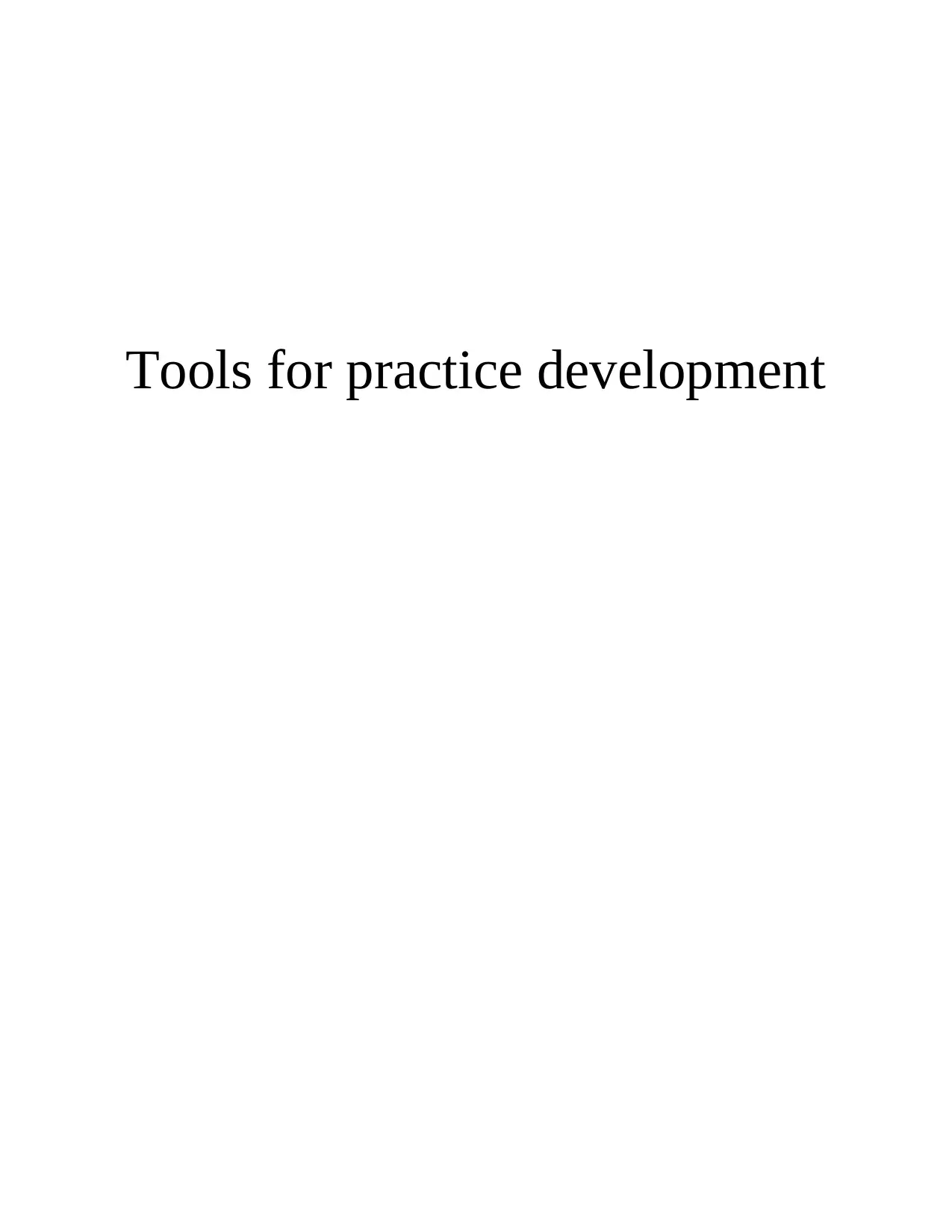
Tools for practice development
Paraphrase This Document
Need a fresh take? Get an instant paraphrase of this document with our AI Paraphraser
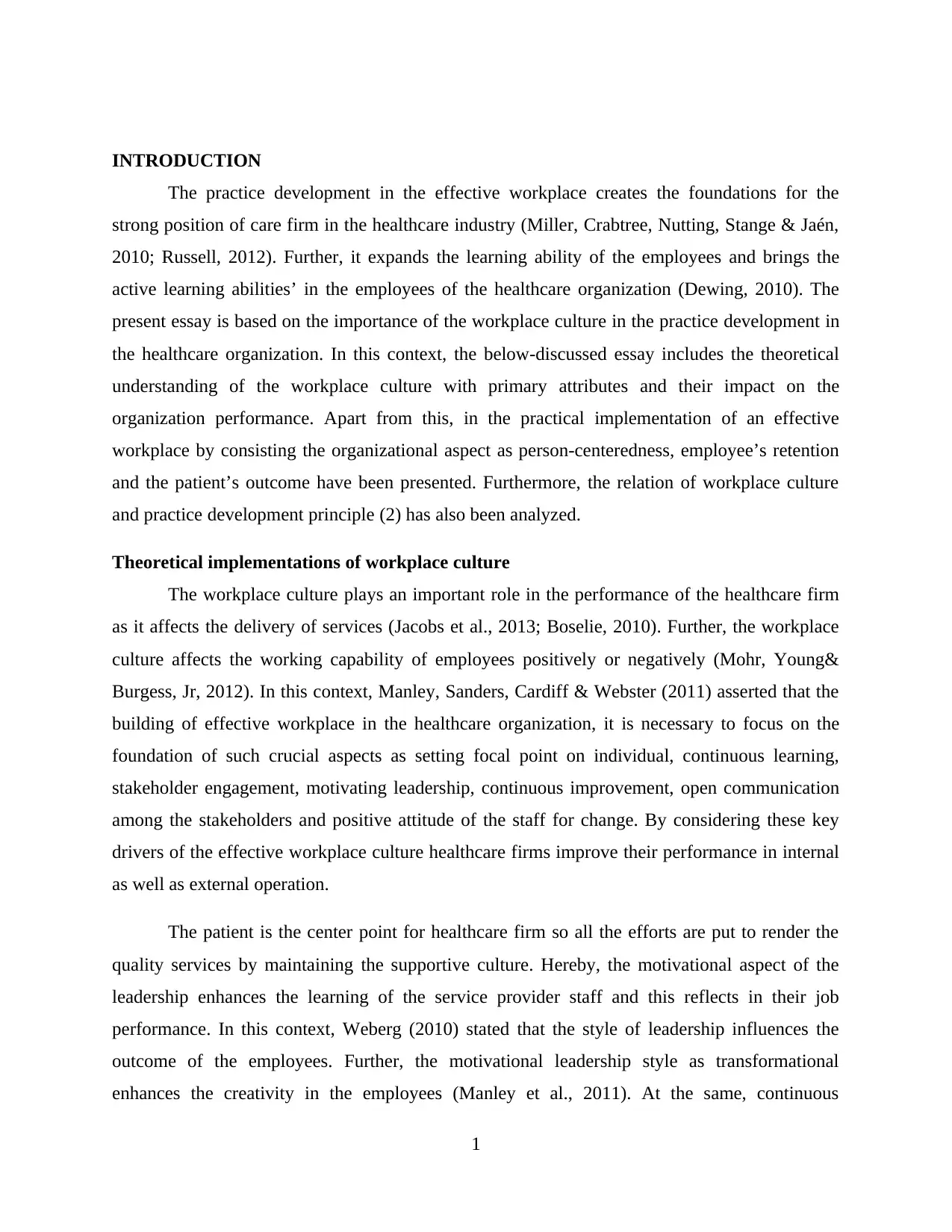
INTRODUCTION
The practice development in the effective workplace creates the foundations for the
strong position of care firm in the healthcare industry (Miller, Crabtree, Nutting, Stange & Jaén,
2010; Russell, 2012). Further, it expands the learning ability of the employees and brings the
active learning abilities’ in the employees of the healthcare organization (Dewing, 2010). The
present essay is based on the importance of the workplace culture in the practice development in
the healthcare organization. In this context, the below-discussed essay includes the theoretical
understanding of the workplace culture with primary attributes and their impact on the
organization performance. Apart from this, in the practical implementation of an effective
workplace by consisting the organizational aspect as person-centeredness, employee’s retention
and the patient’s outcome have been presented. Furthermore, the relation of workplace culture
and practice development principle (2) has also been analyzed.
Theoretical implementations of workplace culture
The workplace culture plays an important role in the performance of the healthcare firm
as it affects the delivery of services (Jacobs et al., 2013; Boselie, 2010). Further, the workplace
culture affects the working capability of employees positively or negatively (Mohr, Young&
Burgess, Jr, 2012). In this context, Manley, Sanders, Cardiff & Webster (2011) asserted that the
building of effective workplace in the healthcare organization, it is necessary to focus on the
foundation of such crucial aspects as setting focal point on individual, continuous learning,
stakeholder engagement, motivating leadership, continuous improvement, open communication
among the stakeholders and positive attitude of the staff for change. By considering these key
drivers of the effective workplace culture healthcare firms improve their performance in internal
as well as external operation.
The patient is the center point for healthcare firm so all the efforts are put to render the
quality services by maintaining the supportive culture. Hereby, the motivational aspect of the
leadership enhances the learning of the service provider staff and this reflects in their job
performance. In this context, Weberg (2010) stated that the style of leadership influences the
outcome of the employees. Further, the motivational leadership style as transformational
enhances the creativity in the employees (Manley et al., 2011). At the same, continuous
1
The practice development in the effective workplace creates the foundations for the
strong position of care firm in the healthcare industry (Miller, Crabtree, Nutting, Stange & Jaén,
2010; Russell, 2012). Further, it expands the learning ability of the employees and brings the
active learning abilities’ in the employees of the healthcare organization (Dewing, 2010). The
present essay is based on the importance of the workplace culture in the practice development in
the healthcare organization. In this context, the below-discussed essay includes the theoretical
understanding of the workplace culture with primary attributes and their impact on the
organization performance. Apart from this, in the practical implementation of an effective
workplace by consisting the organizational aspect as person-centeredness, employee’s retention
and the patient’s outcome have been presented. Furthermore, the relation of workplace culture
and practice development principle (2) has also been analyzed.
Theoretical implementations of workplace culture
The workplace culture plays an important role in the performance of the healthcare firm
as it affects the delivery of services (Jacobs et al., 2013; Boselie, 2010). Further, the workplace
culture affects the working capability of employees positively or negatively (Mohr, Young&
Burgess, Jr, 2012). In this context, Manley, Sanders, Cardiff & Webster (2011) asserted that the
building of effective workplace in the healthcare organization, it is necessary to focus on the
foundation of such crucial aspects as setting focal point on individual, continuous learning,
stakeholder engagement, motivating leadership, continuous improvement, open communication
among the stakeholders and positive attitude of the staff for change. By considering these key
drivers of the effective workplace culture healthcare firms improve their performance in internal
as well as external operation.
The patient is the center point for healthcare firm so all the efforts are put to render the
quality services by maintaining the supportive culture. Hereby, the motivational aspect of the
leadership enhances the learning of the service provider staff and this reflects in their job
performance. In this context, Weberg (2010) stated that the style of leadership influences the
outcome of the employees. Further, the motivational leadership style as transformational
enhances the creativity in the employees (Manley et al., 2011). At the same, continuous
1
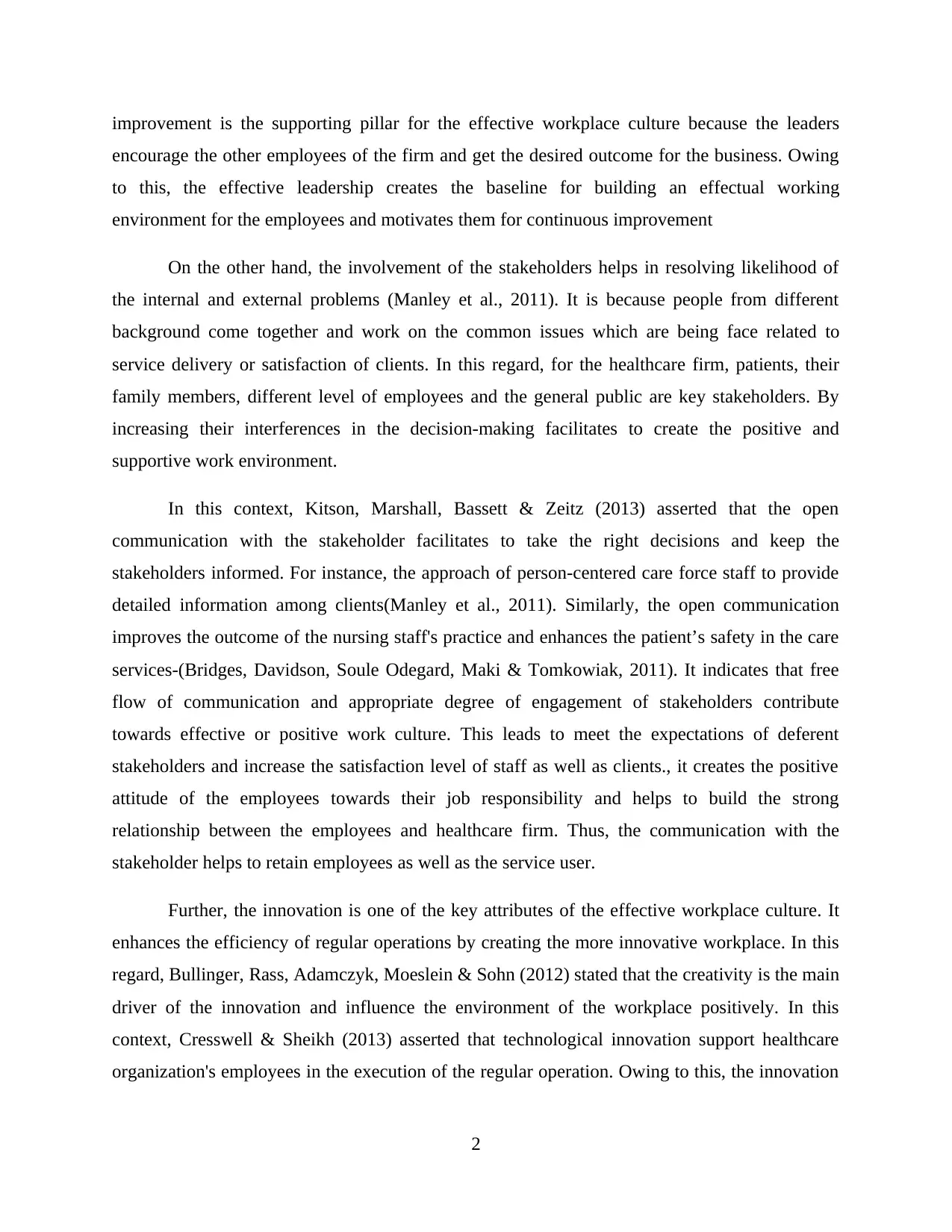
improvement is the supporting pillar for the effective workplace culture because the leaders
encourage the other employees of the firm and get the desired outcome for the business. Owing
to this, the effective leadership creates the baseline for building an effectual working
environment for the employees and motivates them for continuous improvement
On the other hand, the involvement of the stakeholders helps in resolving likelihood of
the internal and external problems (Manley et al., 2011). It is because people from different
background come together and work on the common issues which are being face related to
service delivery or satisfaction of clients. In this regard, for the healthcare firm, patients, their
family members, different level of employees and the general public are key stakeholders. By
increasing their interferences in the decision-making facilitates to create the positive and
supportive work environment.
In this context, Kitson, Marshall, Bassett & Zeitz (2013) asserted that the open
communication with the stakeholder facilitates to take the right decisions and keep the
stakeholders informed. For instance, the approach of person-centered care force staff to provide
detailed information among clients(Manley et al., 2011). Similarly, the open communication
improves the outcome of the nursing staff's practice and enhances the patient’s safety in the care
services-(Bridges, Davidson, Soule Odegard, Maki & Tomkowiak, 2011). It indicates that free
flow of communication and appropriate degree of engagement of stakeholders contribute
towards effective or positive work culture. This leads to meet the expectations of deferent
stakeholders and increase the satisfaction level of staff as well as clients., it creates the positive
attitude of the employees towards their job responsibility and helps to build the strong
relationship between the employees and healthcare firm. Thus, the communication with the
stakeholder helps to retain employees as well as the service user.
Further, the innovation is one of the key attributes of the effective workplace culture. It
enhances the efficiency of regular operations by creating the more innovative workplace. In this
regard, Bullinger, Rass, Adamczyk, Moeslein & Sohn (2012) stated that the creativity is the main
driver of the innovation and influence the environment of the workplace positively. In this
context, Cresswell & Sheikh (2013) asserted that technological innovation support healthcare
organization's employees in the execution of the regular operation. Owing to this, the innovation
2
encourage the other employees of the firm and get the desired outcome for the business. Owing
to this, the effective leadership creates the baseline for building an effectual working
environment for the employees and motivates them for continuous improvement
On the other hand, the involvement of the stakeholders helps in resolving likelihood of
the internal and external problems (Manley et al., 2011). It is because people from different
background come together and work on the common issues which are being face related to
service delivery or satisfaction of clients. In this regard, for the healthcare firm, patients, their
family members, different level of employees and the general public are key stakeholders. By
increasing their interferences in the decision-making facilitates to create the positive and
supportive work environment.
In this context, Kitson, Marshall, Bassett & Zeitz (2013) asserted that the open
communication with the stakeholder facilitates to take the right decisions and keep the
stakeholders informed. For instance, the approach of person-centered care force staff to provide
detailed information among clients(Manley et al., 2011). Similarly, the open communication
improves the outcome of the nursing staff's practice and enhances the patient’s safety in the care
services-(Bridges, Davidson, Soule Odegard, Maki & Tomkowiak, 2011). It indicates that free
flow of communication and appropriate degree of engagement of stakeholders contribute
towards effective or positive work culture. This leads to meet the expectations of deferent
stakeholders and increase the satisfaction level of staff as well as clients., it creates the positive
attitude of the employees towards their job responsibility and helps to build the strong
relationship between the employees and healthcare firm. Thus, the communication with the
stakeholder helps to retain employees as well as the service user.
Further, the innovation is one of the key attributes of the effective workplace culture. It
enhances the efficiency of regular operations by creating the more innovative workplace. In this
regard, Bullinger, Rass, Adamczyk, Moeslein & Sohn (2012) stated that the creativity is the main
driver of the innovation and influence the environment of the workplace positively. In this
context, Cresswell & Sheikh (2013) asserted that technological innovation support healthcare
organization's employees in the execution of the regular operation. Owing to this, the innovation
2
⊘ This is a preview!⊘
Do you want full access?
Subscribe today to unlock all pages.

Trusted by 1+ million students worldwide
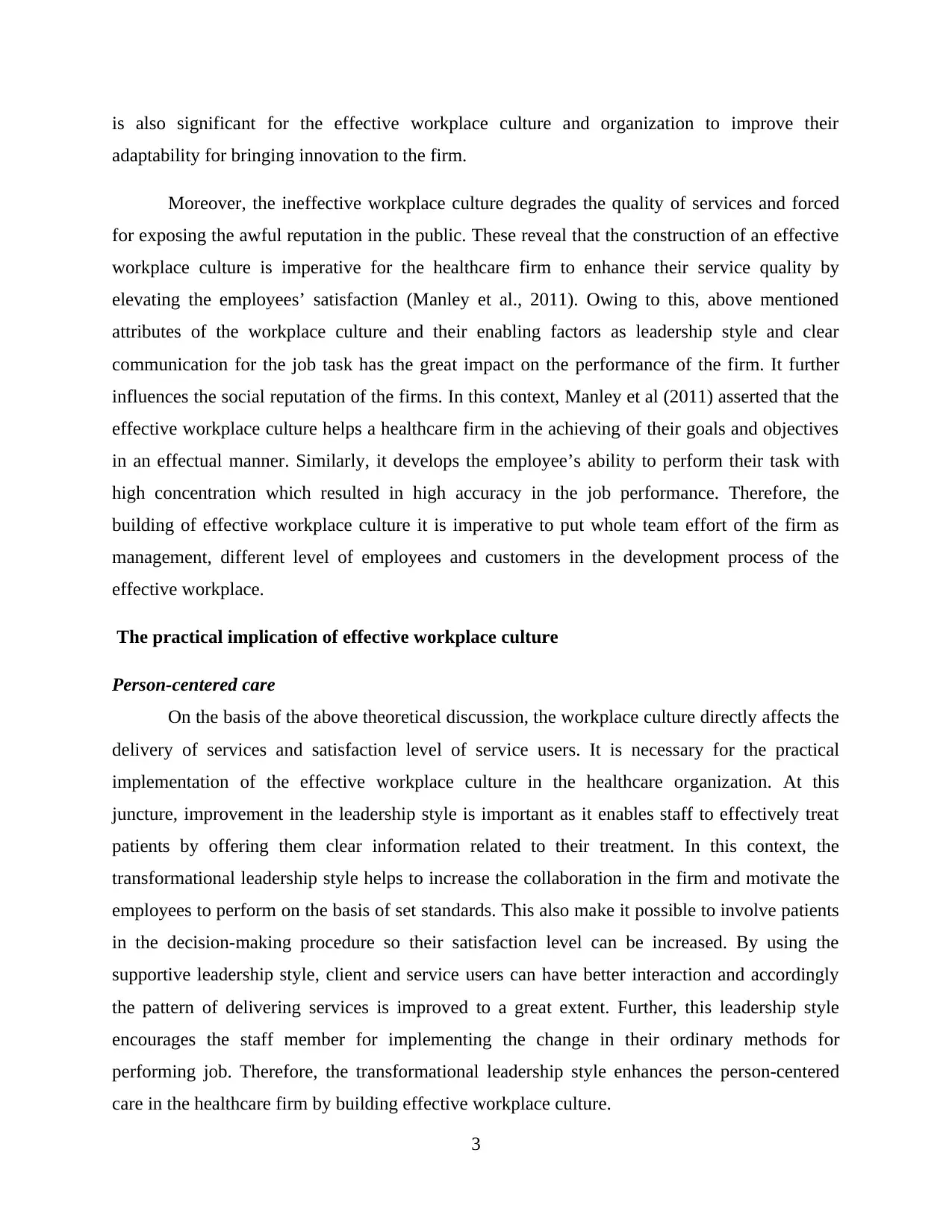
is also significant for the effective workplace culture and organization to improve their
adaptability for bringing innovation to the firm.
Moreover, the ineffective workplace culture degrades the quality of services and forced
for exposing the awful reputation in the public. These reveal that the construction of an effective
workplace culture is imperative for the healthcare firm to enhance their service quality by
elevating the employees’ satisfaction (Manley et al., 2011). Owing to this, above mentioned
attributes of the workplace culture and their enabling factors as leadership style and clear
communication for the job task has the great impact on the performance of the firm. It further
influences the social reputation of the firms. In this context, Manley et al (2011) asserted that the
effective workplace culture helps a healthcare firm in the achieving of their goals and objectives
in an effectual manner. Similarly, it develops the employee’s ability to perform their task with
high concentration which resulted in high accuracy in the job performance. Therefore, the
building of effective workplace culture it is imperative to put whole team effort of the firm as
management, different level of employees and customers in the development process of the
effective workplace.
The practical implication of effective workplace culture
Person-centered care
On the basis of the above theoretical discussion, the workplace culture directly affects the
delivery of services and satisfaction level of service users. It is necessary for the practical
implementation of the effective workplace culture in the healthcare organization. At this
juncture, improvement in the leadership style is important as it enables staff to effectively treat
patients by offering them clear information related to their treatment. In this context, the
transformational leadership style helps to increase the collaboration in the firm and motivate the
employees to perform on the basis of set standards. This also make it possible to involve patients
in the decision-making procedure so their satisfaction level can be increased. By using the
supportive leadership style, client and service users can have better interaction and accordingly
the pattern of delivering services is improved to a great extent. Further, this leadership style
encourages the staff member for implementing the change in their ordinary methods for
performing job. Therefore, the transformational leadership style enhances the person-centered
care in the healthcare firm by building effective workplace culture.
3
adaptability for bringing innovation to the firm.
Moreover, the ineffective workplace culture degrades the quality of services and forced
for exposing the awful reputation in the public. These reveal that the construction of an effective
workplace culture is imperative for the healthcare firm to enhance their service quality by
elevating the employees’ satisfaction (Manley et al., 2011). Owing to this, above mentioned
attributes of the workplace culture and their enabling factors as leadership style and clear
communication for the job task has the great impact on the performance of the firm. It further
influences the social reputation of the firms. In this context, Manley et al (2011) asserted that the
effective workplace culture helps a healthcare firm in the achieving of their goals and objectives
in an effectual manner. Similarly, it develops the employee’s ability to perform their task with
high concentration which resulted in high accuracy in the job performance. Therefore, the
building of effective workplace culture it is imperative to put whole team effort of the firm as
management, different level of employees and customers in the development process of the
effective workplace.
The practical implication of effective workplace culture
Person-centered care
On the basis of the above theoretical discussion, the workplace culture directly affects the
delivery of services and satisfaction level of service users. It is necessary for the practical
implementation of the effective workplace culture in the healthcare organization. At this
juncture, improvement in the leadership style is important as it enables staff to effectively treat
patients by offering them clear information related to their treatment. In this context, the
transformational leadership style helps to increase the collaboration in the firm and motivate the
employees to perform on the basis of set standards. This also make it possible to involve patients
in the decision-making procedure so their satisfaction level can be increased. By using the
supportive leadership style, client and service users can have better interaction and accordingly
the pattern of delivering services is improved to a great extent. Further, this leadership style
encourages the staff member for implementing the change in their ordinary methods for
performing job. Therefore, the transformational leadership style enhances the person-centered
care in the healthcare firm by building effective workplace culture.
3
Paraphrase This Document
Need a fresh take? Get an instant paraphrase of this document with our AI Paraphraser
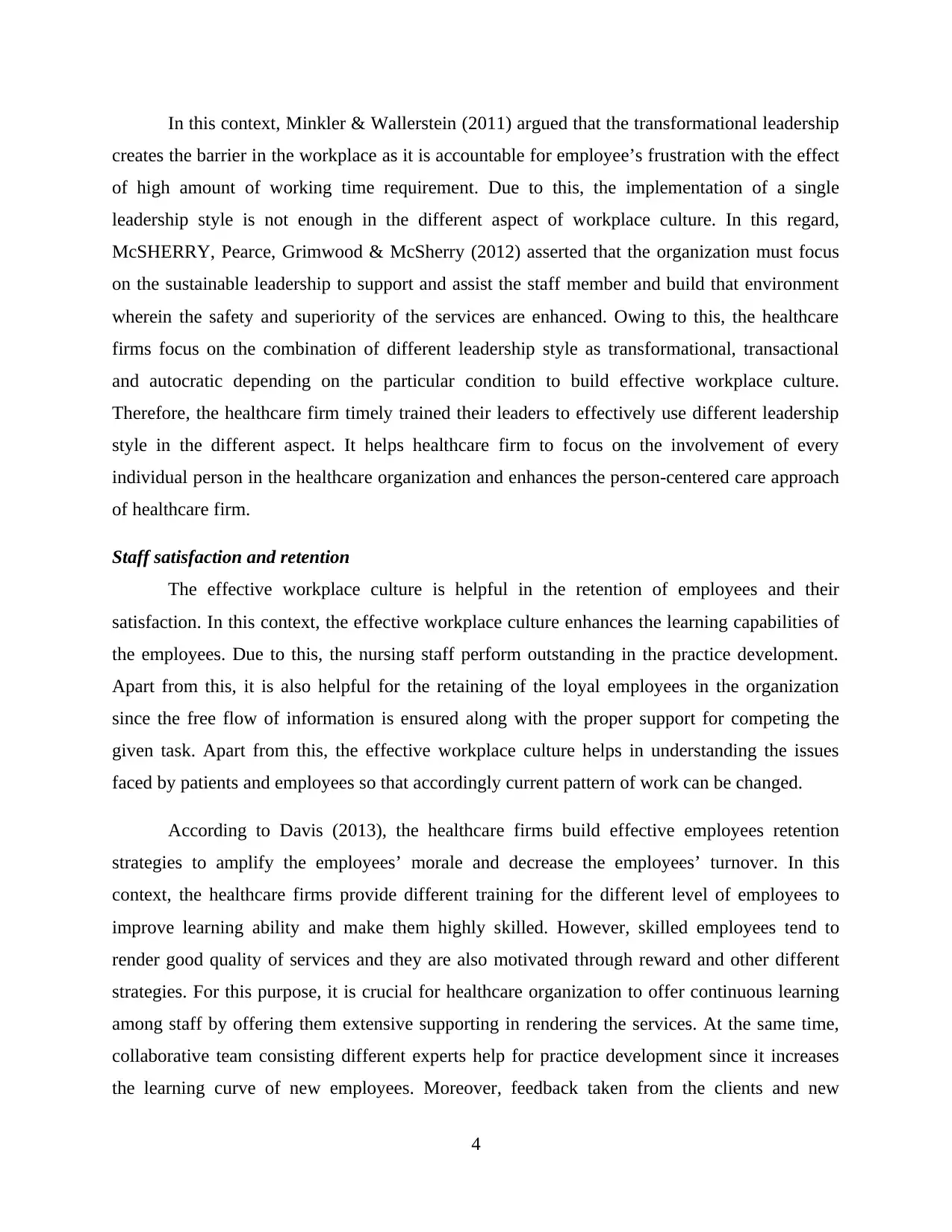
In this context, Minkler & Wallerstein (2011) argued that the transformational leadership
creates the barrier in the workplace as it is accountable for employee’s frustration with the effect
of high amount of working time requirement. Due to this, the implementation of a single
leadership style is not enough in the different aspect of workplace culture. In this regard,
McSHERRY, Pearce, Grimwood & McSherry (2012) asserted that the organization must focus
on the sustainable leadership to support and assist the staff member and build that environment
wherein the safety and superiority of the services are enhanced. Owing to this, the healthcare
firms focus on the combination of different leadership style as transformational, transactional
and autocratic depending on the particular condition to build effective workplace culture.
Therefore, the healthcare firm timely trained their leaders to effectively use different leadership
style in the different aspect. It helps healthcare firm to focus on the involvement of every
individual person in the healthcare organization and enhances the person-centered care approach
of healthcare firm.
Staff satisfaction and retention
The effective workplace culture is helpful in the retention of employees and their
satisfaction. In this context, the effective workplace culture enhances the learning capabilities of
the employees. Due to this, the nursing staff perform outstanding in the practice development.
Apart from this, it is also helpful for the retaining of the loyal employees in the organization
since the free flow of information is ensured along with the proper support for competing the
given task. Apart from this, the effective workplace culture helps in understanding the issues
faced by patients and employees so that accordingly current pattern of work can be changed.
According to Davis (2013), the healthcare firms build effective employees retention
strategies to amplify the employees’ morale and decrease the employees’ turnover. In this
context, the healthcare firms provide different training for the different level of employees to
improve learning ability and make them highly skilled. However, skilled employees tend to
render good quality of services and they are also motivated through reward and other different
strategies. For this purpose, it is crucial for healthcare organization to offer continuous learning
among staff by offering them extensive supporting in rendering the services. At the same time,
collaborative team consisting different experts help for practice development since it increases
the learning curve of new employees. Moreover, feedback taken from the clients and new
4
creates the barrier in the workplace as it is accountable for employee’s frustration with the effect
of high amount of working time requirement. Due to this, the implementation of a single
leadership style is not enough in the different aspect of workplace culture. In this regard,
McSHERRY, Pearce, Grimwood & McSherry (2012) asserted that the organization must focus
on the sustainable leadership to support and assist the staff member and build that environment
wherein the safety and superiority of the services are enhanced. Owing to this, the healthcare
firms focus on the combination of different leadership style as transformational, transactional
and autocratic depending on the particular condition to build effective workplace culture.
Therefore, the healthcare firm timely trained their leaders to effectively use different leadership
style in the different aspect. It helps healthcare firm to focus on the involvement of every
individual person in the healthcare organization and enhances the person-centered care approach
of healthcare firm.
Staff satisfaction and retention
The effective workplace culture is helpful in the retention of employees and their
satisfaction. In this context, the effective workplace culture enhances the learning capabilities of
the employees. Due to this, the nursing staff perform outstanding in the practice development.
Apart from this, it is also helpful for the retaining of the loyal employees in the organization
since the free flow of information is ensured along with the proper support for competing the
given task. Apart from this, the effective workplace culture helps in understanding the issues
faced by patients and employees so that accordingly current pattern of work can be changed.
According to Davis (2013), the healthcare firms build effective employees retention
strategies to amplify the employees’ morale and decrease the employees’ turnover. In this
context, the healthcare firms provide different training for the different level of employees to
improve learning ability and make them highly skilled. However, skilled employees tend to
render good quality of services and they are also motivated through reward and other different
strategies. For this purpose, it is crucial for healthcare organization to offer continuous learning
among staff by offering them extensive supporting in rendering the services. At the same time,
collaborative team consisting different experts help for practice development since it increases
the learning curve of new employees. Moreover, feedback taken from the clients and new
4
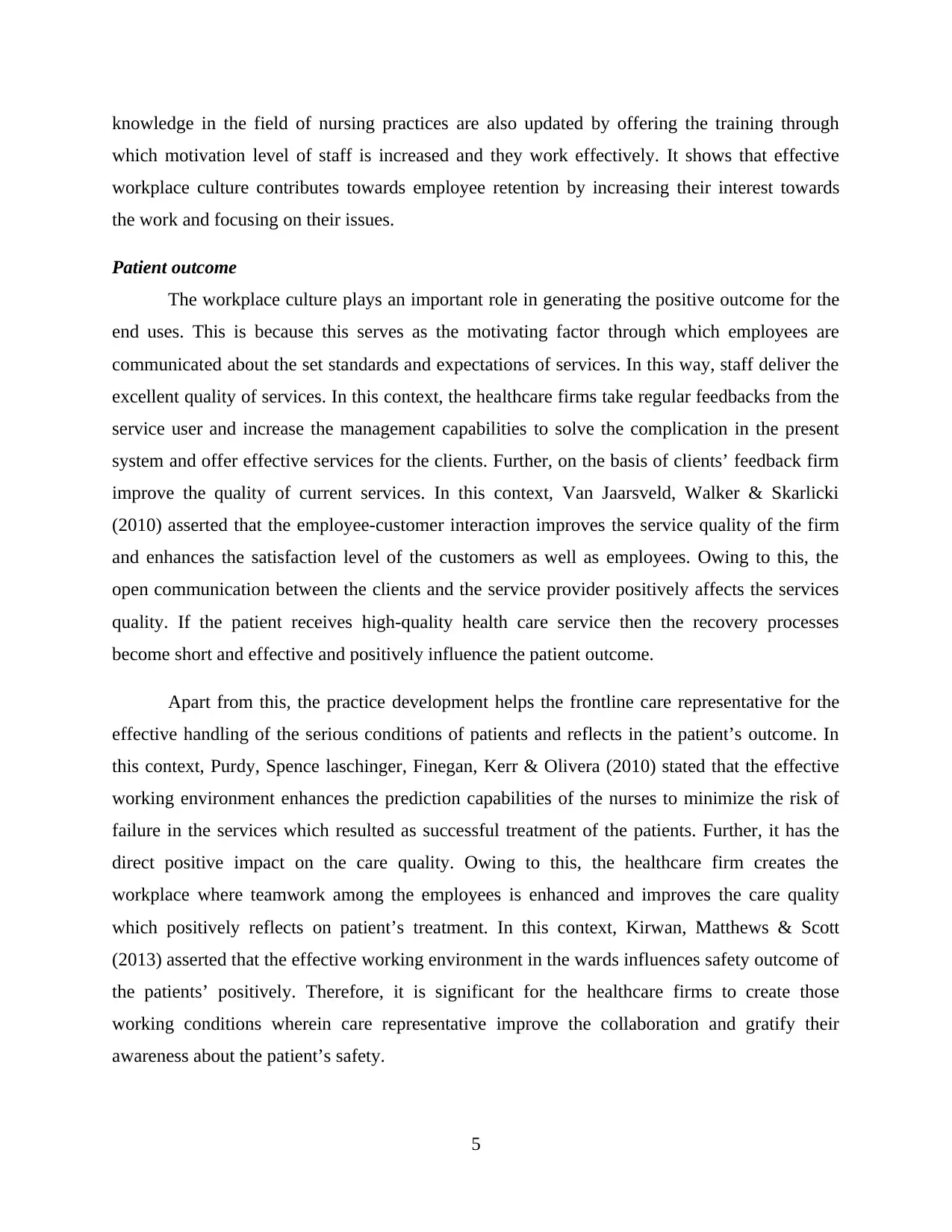
knowledge in the field of nursing practices are also updated by offering the training through
which motivation level of staff is increased and they work effectively. It shows that effective
workplace culture contributes towards employee retention by increasing their interest towards
the work and focusing on their issues.
Patient outcome
The workplace culture plays an important role in generating the positive outcome for the
end uses. This is because this serves as the motivating factor through which employees are
communicated about the set standards and expectations of services. In this way, staff deliver the
excellent quality of services. In this context, the healthcare firms take regular feedbacks from the
service user and increase the management capabilities to solve the complication in the present
system and offer effective services for the clients. Further, on the basis of clients’ feedback firm
improve the quality of current services. In this context, Van Jaarsveld, Walker & Skarlicki
(2010) asserted that the employee-customer interaction improves the service quality of the firm
and enhances the satisfaction level of the customers as well as employees. Owing to this, the
open communication between the clients and the service provider positively affects the services
quality. If the patient receives high-quality health care service then the recovery processes
become short and effective and positively influence the patient outcome.
Apart from this, the practice development helps the frontline care representative for the
effective handling of the serious conditions of patients and reflects in the patient’s outcome. In
this context, Purdy, Spence laschinger, Finegan, Kerr & Olivera (2010) stated that the effective
working environment enhances the prediction capabilities of the nurses to minimize the risk of
failure in the services which resulted as successful treatment of the patients. Further, it has the
direct positive impact on the care quality. Owing to this, the healthcare firm creates the
workplace where teamwork among the employees is enhanced and improves the care quality
which positively reflects on patient’s treatment. In this context, Kirwan, Matthews & Scott
(2013) asserted that the effective working environment in the wards influences safety outcome of
the patients’ positively. Therefore, it is significant for the healthcare firms to create those
working conditions wherein care representative improve the collaboration and gratify their
awareness about the patient’s safety.
5
which motivation level of staff is increased and they work effectively. It shows that effective
workplace culture contributes towards employee retention by increasing their interest towards
the work and focusing on their issues.
Patient outcome
The workplace culture plays an important role in generating the positive outcome for the
end uses. This is because this serves as the motivating factor through which employees are
communicated about the set standards and expectations of services. In this way, staff deliver the
excellent quality of services. In this context, the healthcare firms take regular feedbacks from the
service user and increase the management capabilities to solve the complication in the present
system and offer effective services for the clients. Further, on the basis of clients’ feedback firm
improve the quality of current services. In this context, Van Jaarsveld, Walker & Skarlicki
(2010) asserted that the employee-customer interaction improves the service quality of the firm
and enhances the satisfaction level of the customers as well as employees. Owing to this, the
open communication between the clients and the service provider positively affects the services
quality. If the patient receives high-quality health care service then the recovery processes
become short and effective and positively influence the patient outcome.
Apart from this, the practice development helps the frontline care representative for the
effective handling of the serious conditions of patients and reflects in the patient’s outcome. In
this context, Purdy, Spence laschinger, Finegan, Kerr & Olivera (2010) stated that the effective
working environment enhances the prediction capabilities of the nurses to minimize the risk of
failure in the services which resulted as successful treatment of the patients. Further, it has the
direct positive impact on the care quality. Owing to this, the healthcare firm creates the
workplace where teamwork among the employees is enhanced and improves the care quality
which positively reflects on patient’s treatment. In this context, Kirwan, Matthews & Scott
(2013) asserted that the effective working environment in the wards influences safety outcome of
the patients’ positively. Therefore, it is significant for the healthcare firms to create those
working conditions wherein care representative improve the collaboration and gratify their
awareness about the patient’s safety.
5
⊘ This is a preview!⊘
Do you want full access?
Subscribe today to unlock all pages.

Trusted by 1+ million students worldwide
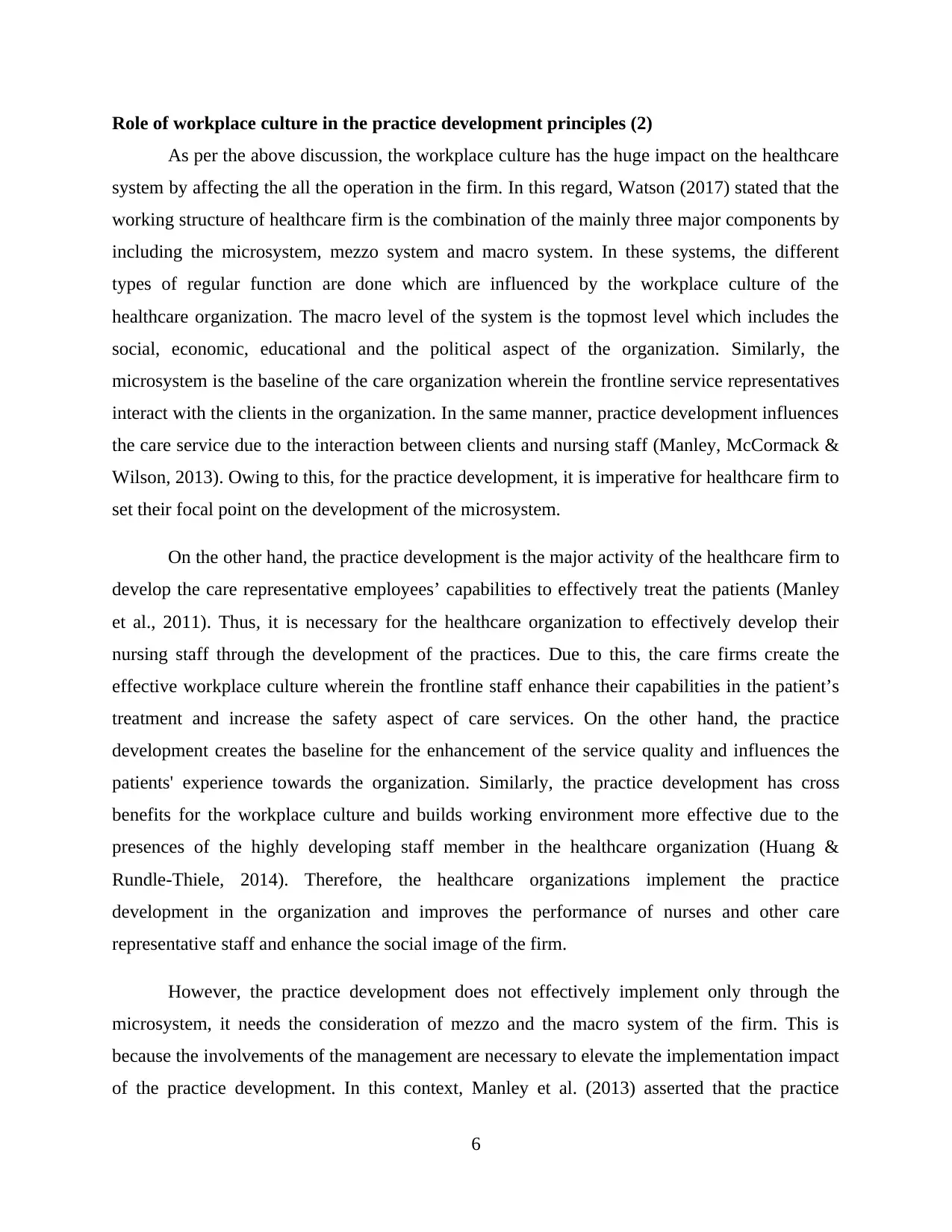
Role of workplace culture in the practice development principles (2)
As per the above discussion, the workplace culture has the huge impact on the healthcare
system by affecting the all the operation in the firm. In this regard, Watson (2017) stated that the
working structure of healthcare firm is the combination of the mainly three major components by
including the microsystem, mezzo system and macro system. In these systems, the different
types of regular function are done which are influenced by the workplace culture of the
healthcare organization. The macro level of the system is the topmost level which includes the
social, economic, educational and the political aspect of the organization. Similarly, the
microsystem is the baseline of the care organization wherein the frontline service representatives
interact with the clients in the organization. In the same manner, practice development influences
the care service due to the interaction between clients and nursing staff (Manley, McCormack &
Wilson, 2013). Owing to this, for the practice development, it is imperative for healthcare firm to
set their focal point on the development of the microsystem.
On the other hand, the practice development is the major activity of the healthcare firm to
develop the care representative employees’ capabilities to effectively treat the patients (Manley
et al., 2011). Thus, it is necessary for the healthcare organization to effectively develop their
nursing staff through the development of the practices. Due to this, the care firms create the
effective workplace culture wherein the frontline staff enhance their capabilities in the patient’s
treatment and increase the safety aspect of care services. On the other hand, the practice
development creates the baseline for the enhancement of the service quality and influences the
patients' experience towards the organization. Similarly, the practice development has cross
benefits for the workplace culture and builds working environment more effective due to the
presences of the highly developing staff member in the healthcare organization (Huang &
Rundle-Thiele, 2014). Therefore, the healthcare organizations implement the practice
development in the organization and improves the performance of nurses and other care
representative staff and enhance the social image of the firm.
However, the practice development does not effectively implement only through the
microsystem, it needs the consideration of mezzo and the macro system of the firm. This is
because the involvements of the management are necessary to elevate the implementation impact
of the practice development. In this context, Manley et al. (2013) asserted that the practice
6
As per the above discussion, the workplace culture has the huge impact on the healthcare
system by affecting the all the operation in the firm. In this regard, Watson (2017) stated that the
working structure of healthcare firm is the combination of the mainly three major components by
including the microsystem, mezzo system and macro system. In these systems, the different
types of regular function are done which are influenced by the workplace culture of the
healthcare organization. The macro level of the system is the topmost level which includes the
social, economic, educational and the political aspect of the organization. Similarly, the
microsystem is the baseline of the care organization wherein the frontline service representatives
interact with the clients in the organization. In the same manner, practice development influences
the care service due to the interaction between clients and nursing staff (Manley, McCormack &
Wilson, 2013). Owing to this, for the practice development, it is imperative for healthcare firm to
set their focal point on the development of the microsystem.
On the other hand, the practice development is the major activity of the healthcare firm to
develop the care representative employees’ capabilities to effectively treat the patients (Manley
et al., 2011). Thus, it is necessary for the healthcare organization to effectively develop their
nursing staff through the development of the practices. Due to this, the care firms create the
effective workplace culture wherein the frontline staff enhance their capabilities in the patient’s
treatment and increase the safety aspect of care services. On the other hand, the practice
development creates the baseline for the enhancement of the service quality and influences the
patients' experience towards the organization. Similarly, the practice development has cross
benefits for the workplace culture and builds working environment more effective due to the
presences of the highly developing staff member in the healthcare organization (Huang &
Rundle-Thiele, 2014). Therefore, the healthcare organizations implement the practice
development in the organization and improves the performance of nurses and other care
representative staff and enhance the social image of the firm.
However, the practice development does not effectively implement only through the
microsystem, it needs the consideration of mezzo and the macro system of the firm. This is
because the involvements of the management are necessary to elevate the implementation impact
of the practice development. In this context, Manley et al. (2013) asserted that the practice
6
Paraphrase This Document
Need a fresh take? Get an instant paraphrase of this document with our AI Paraphraser
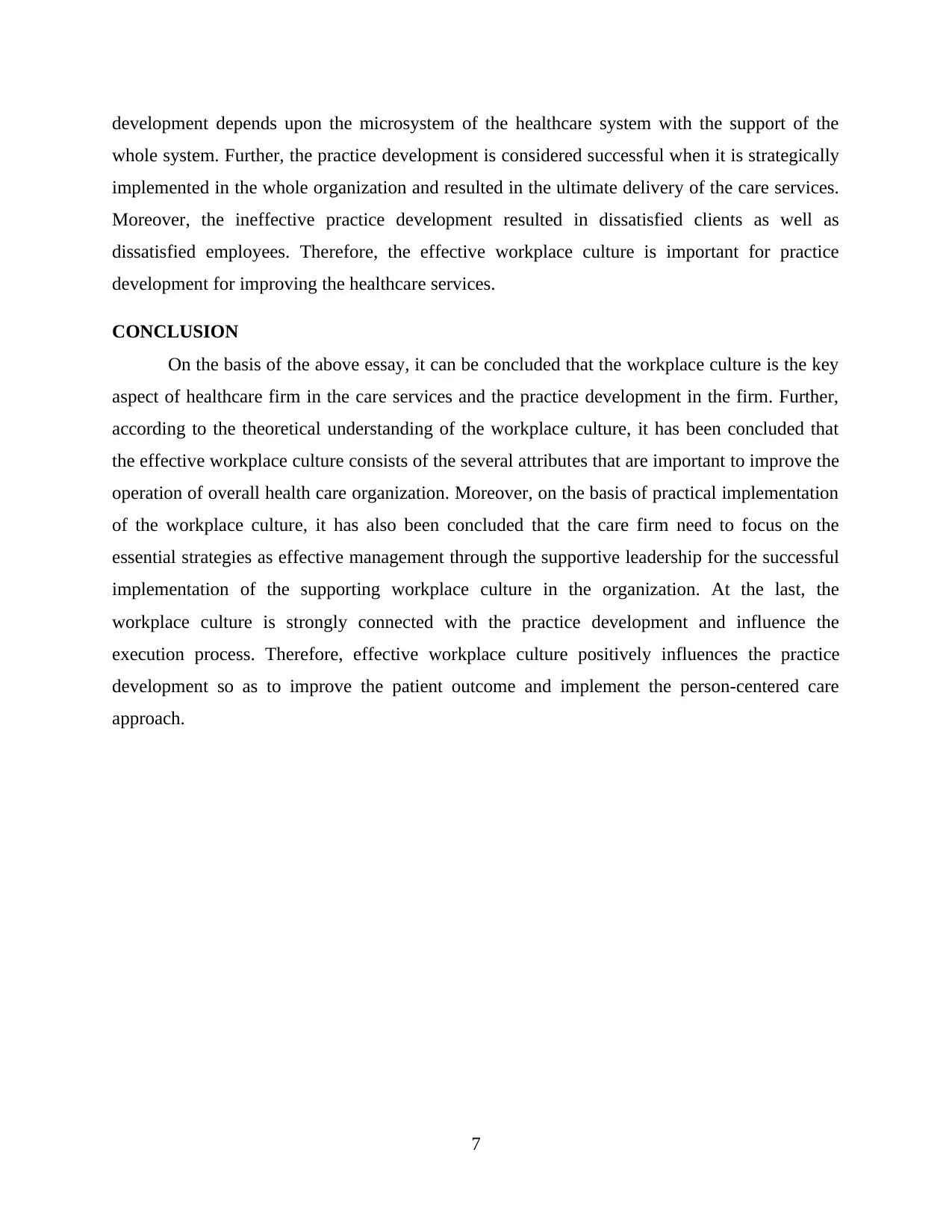
development depends upon the microsystem of the healthcare system with the support of the
whole system. Further, the practice development is considered successful when it is strategically
implemented in the whole organization and resulted in the ultimate delivery of the care services.
Moreover, the ineffective practice development resulted in dissatisfied clients as well as
dissatisfied employees. Therefore, the effective workplace culture is important for practice
development for improving the healthcare services.
CONCLUSION
On the basis of the above essay, it can be concluded that the workplace culture is the key
aspect of healthcare firm in the care services and the practice development in the firm. Further,
according to the theoretical understanding of the workplace culture, it has been concluded that
the effective workplace culture consists of the several attributes that are important to improve the
operation of overall health care organization. Moreover, on the basis of practical implementation
of the workplace culture, it has also been concluded that the care firm need to focus on the
essential strategies as effective management through the supportive leadership for the successful
implementation of the supporting workplace culture in the organization. At the last, the
workplace culture is strongly connected with the practice development and influence the
execution process. Therefore, effective workplace culture positively influences the practice
development so as to improve the patient outcome and implement the person-centered care
approach.
7
whole system. Further, the practice development is considered successful when it is strategically
implemented in the whole organization and resulted in the ultimate delivery of the care services.
Moreover, the ineffective practice development resulted in dissatisfied clients as well as
dissatisfied employees. Therefore, the effective workplace culture is important for practice
development for improving the healthcare services.
CONCLUSION
On the basis of the above essay, it can be concluded that the workplace culture is the key
aspect of healthcare firm in the care services and the practice development in the firm. Further,
according to the theoretical understanding of the workplace culture, it has been concluded that
the effective workplace culture consists of the several attributes that are important to improve the
operation of overall health care organization. Moreover, on the basis of practical implementation
of the workplace culture, it has also been concluded that the care firm need to focus on the
essential strategies as effective management through the supportive leadership for the successful
implementation of the supporting workplace culture in the organization. At the last, the
workplace culture is strongly connected with the practice development and influence the
execution process. Therefore, effective workplace culture positively influences the practice
development so as to improve the patient outcome and implement the person-centered care
approach.
7
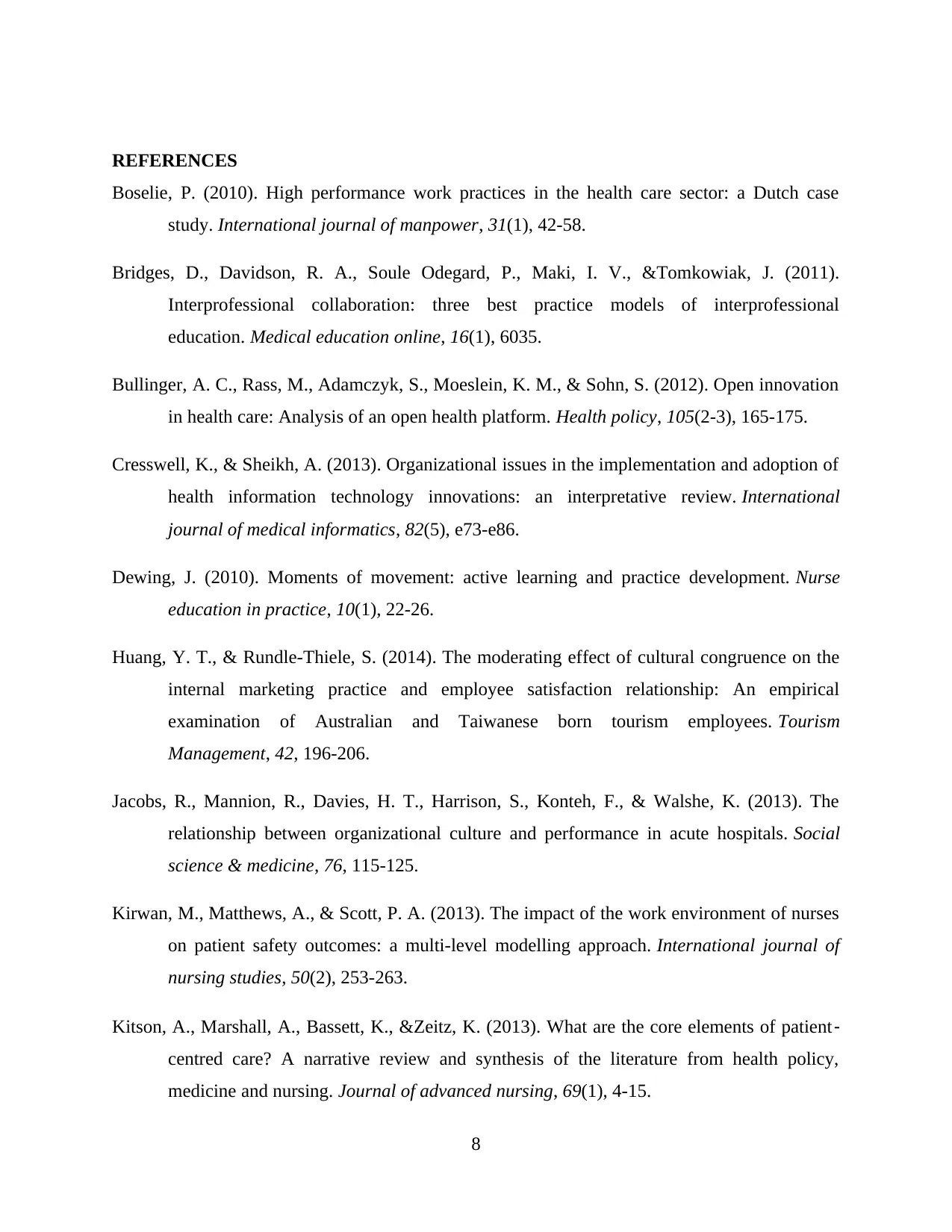
REFERENCES
Boselie, P. (2010). High performance work practices in the health care sector: a Dutch case
study. International journal of manpower, 31(1), 42-58.
Bridges, D., Davidson, R. A., Soule Odegard, P., Maki, I. V., &Tomkowiak, J. (2011).
Interprofessional collaboration: three best practice models of interprofessional
education. Medical education online, 16(1), 6035.
Bullinger, A. C., Rass, M., Adamczyk, S., Moeslein, K. M., & Sohn, S. (2012). Open innovation
in health care: Analysis of an open health platform. Health policy, 105(2-3), 165-175.
Cresswell, K., & Sheikh, A. (2013). Organizational issues in the implementation and adoption of
health information technology innovations: an interpretative review. International
journal of medical informatics, 82(5), e73-e86.
Dewing, J. (2010). Moments of movement: active learning and practice development. Nurse
education in practice, 10(1), 22-26.
Huang, Y. T., & Rundle-Thiele, S. (2014). The moderating effect of cultural congruence on the
internal marketing practice and employee satisfaction relationship: An empirical
examination of Australian and Taiwanese born tourism employees. Tourism
Management, 42, 196-206.
Jacobs, R., Mannion, R., Davies, H. T., Harrison, S., Konteh, F., & Walshe, K. (2013). The
relationship between organizational culture and performance in acute hospitals. Social
science & medicine, 76, 115-125.
Kirwan, M., Matthews, A., & Scott, P. A. (2013). The impact of the work environment of nurses
on patient safety outcomes: a multi-level modelling approach. International journal of
nursing studies, 50(2), 253-263.
Kitson, A., Marshall, A., Bassett, K., &Zeitz, K. (2013). What are the core elements of patient‐
centred care? A narrative review and synthesis of the literature from health policy,
medicine and nursing. Journal of advanced nursing, 69(1), 4-15.
8
Boselie, P. (2010). High performance work practices in the health care sector: a Dutch case
study. International journal of manpower, 31(1), 42-58.
Bridges, D., Davidson, R. A., Soule Odegard, P., Maki, I. V., &Tomkowiak, J. (2011).
Interprofessional collaboration: three best practice models of interprofessional
education. Medical education online, 16(1), 6035.
Bullinger, A. C., Rass, M., Adamczyk, S., Moeslein, K. M., & Sohn, S. (2012). Open innovation
in health care: Analysis of an open health platform. Health policy, 105(2-3), 165-175.
Cresswell, K., & Sheikh, A. (2013). Organizational issues in the implementation and adoption of
health information technology innovations: an interpretative review. International
journal of medical informatics, 82(5), e73-e86.
Dewing, J. (2010). Moments of movement: active learning and practice development. Nurse
education in practice, 10(1), 22-26.
Huang, Y. T., & Rundle-Thiele, S. (2014). The moderating effect of cultural congruence on the
internal marketing practice and employee satisfaction relationship: An empirical
examination of Australian and Taiwanese born tourism employees. Tourism
Management, 42, 196-206.
Jacobs, R., Mannion, R., Davies, H. T., Harrison, S., Konteh, F., & Walshe, K. (2013). The
relationship between organizational culture and performance in acute hospitals. Social
science & medicine, 76, 115-125.
Kirwan, M., Matthews, A., & Scott, P. A. (2013). The impact of the work environment of nurses
on patient safety outcomes: a multi-level modelling approach. International journal of
nursing studies, 50(2), 253-263.
Kitson, A., Marshall, A., Bassett, K., &Zeitz, K. (2013). What are the core elements of patient‐
centred care? A narrative review and synthesis of the literature from health policy,
medicine and nursing. Journal of advanced nursing, 69(1), 4-15.
8
⊘ This is a preview!⊘
Do you want full access?
Subscribe today to unlock all pages.

Trusted by 1+ million students worldwide
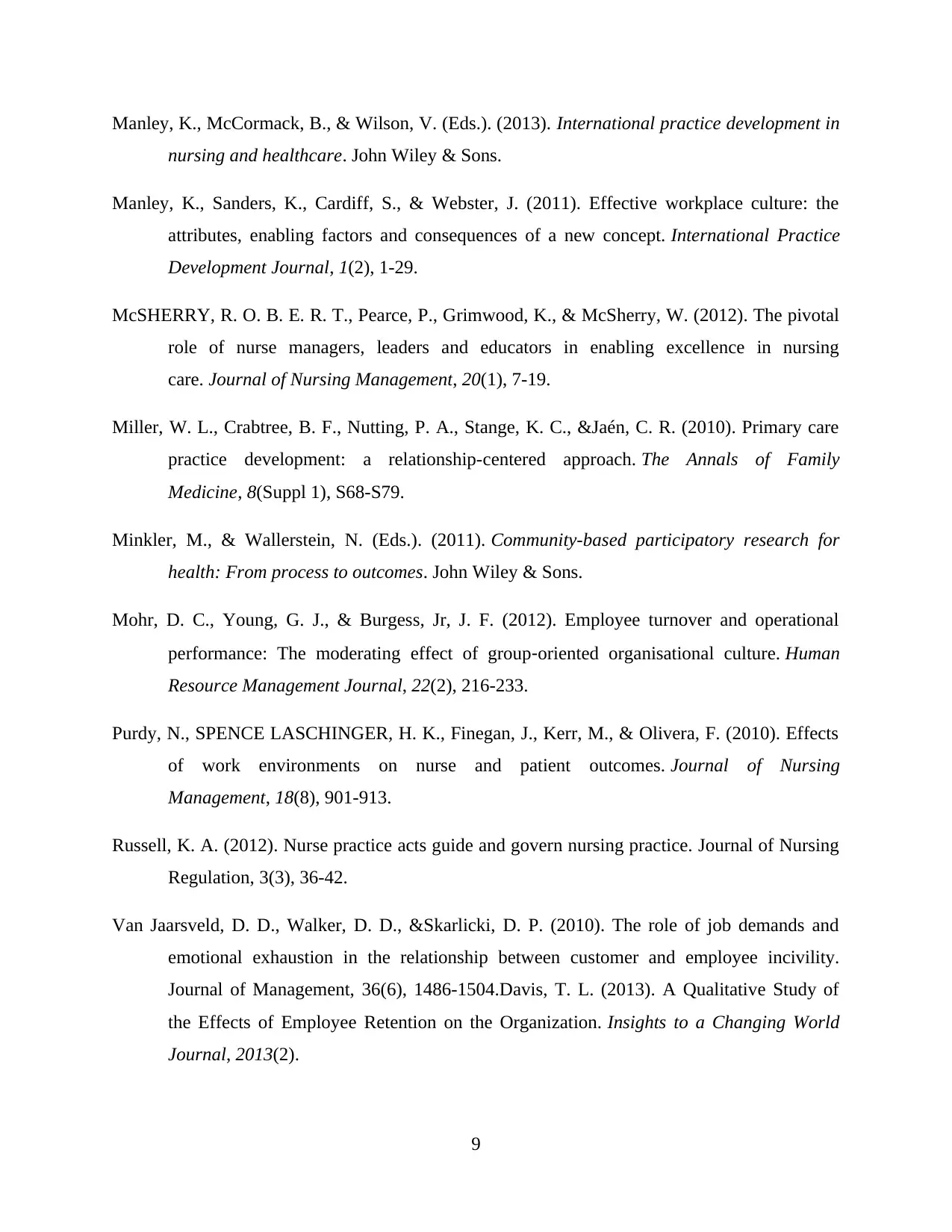
Manley, K., McCormack, B., & Wilson, V. (Eds.). (2013). International practice development in
nursing and healthcare. John Wiley & Sons.
Manley, K., Sanders, K., Cardiff, S., & Webster, J. (2011). Effective workplace culture: the
attributes, enabling factors and consequences of a new concept. International Practice
Development Journal, 1(2), 1-29.
McSHERRY, R. O. B. E. R. T., Pearce, P., Grimwood, K., & McSherry, W. (2012). The pivotal
role of nurse managers, leaders and educators in enabling excellence in nursing
care. Journal of Nursing Management, 20(1), 7-19.
Miller, W. L., Crabtree, B. F., Nutting, P. A., Stange, K. C., &Jaén, C. R. (2010). Primary care
practice development: a relationship-centered approach. The Annals of Family
Medicine, 8(Suppl 1), S68-S79.
Minkler, M., & Wallerstein, N. (Eds.). (2011). Community-based participatory research for
health: From process to outcomes. John Wiley & Sons.
Mohr, D. C., Young, G. J., & Burgess, Jr, J. F. (2012). Employee turnover and operational
performance: The moderating effect of group‐oriented organisational culture. Human
Resource Management Journal, 22(2), 216-233.
Purdy, N., SPENCE LASCHINGER, H. K., Finegan, J., Kerr, M., & Olivera, F. (2010). Effects
of work environments on nurse and patient outcomes. Journal of Nursing
Management, 18(8), 901-913.
Russell, K. A. (2012). Nurse practice acts guide and govern nursing practice. Journal of Nursing
Regulation, 3(3), 36-42.
Van Jaarsveld, D. D., Walker, D. D., &Skarlicki, D. P. (2010). The role of job demands and
emotional exhaustion in the relationship between customer and employee incivility.
Journal of Management, 36(6), 1486-1504.Davis, T. L. (2013). A Qualitative Study of
the Effects of Employee Retention on the Organization. Insights to a Changing World
Journal, 2013(2).
9
nursing and healthcare. John Wiley & Sons.
Manley, K., Sanders, K., Cardiff, S., & Webster, J. (2011). Effective workplace culture: the
attributes, enabling factors and consequences of a new concept. International Practice
Development Journal, 1(2), 1-29.
McSHERRY, R. O. B. E. R. T., Pearce, P., Grimwood, K., & McSherry, W. (2012). The pivotal
role of nurse managers, leaders and educators in enabling excellence in nursing
care. Journal of Nursing Management, 20(1), 7-19.
Miller, W. L., Crabtree, B. F., Nutting, P. A., Stange, K. C., &Jaén, C. R. (2010). Primary care
practice development: a relationship-centered approach. The Annals of Family
Medicine, 8(Suppl 1), S68-S79.
Minkler, M., & Wallerstein, N. (Eds.). (2011). Community-based participatory research for
health: From process to outcomes. John Wiley & Sons.
Mohr, D. C., Young, G. J., & Burgess, Jr, J. F. (2012). Employee turnover and operational
performance: The moderating effect of group‐oriented organisational culture. Human
Resource Management Journal, 22(2), 216-233.
Purdy, N., SPENCE LASCHINGER, H. K., Finegan, J., Kerr, M., & Olivera, F. (2010). Effects
of work environments on nurse and patient outcomes. Journal of Nursing
Management, 18(8), 901-913.
Russell, K. A. (2012). Nurse practice acts guide and govern nursing practice. Journal of Nursing
Regulation, 3(3), 36-42.
Van Jaarsveld, D. D., Walker, D. D., &Skarlicki, D. P. (2010). The role of job demands and
emotional exhaustion in the relationship between customer and employee incivility.
Journal of Management, 36(6), 1486-1504.Davis, T. L. (2013). A Qualitative Study of
the Effects of Employee Retention on the Organization. Insights to a Changing World
Journal, 2013(2).
9
Paraphrase This Document
Need a fresh take? Get an instant paraphrase of this document with our AI Paraphraser
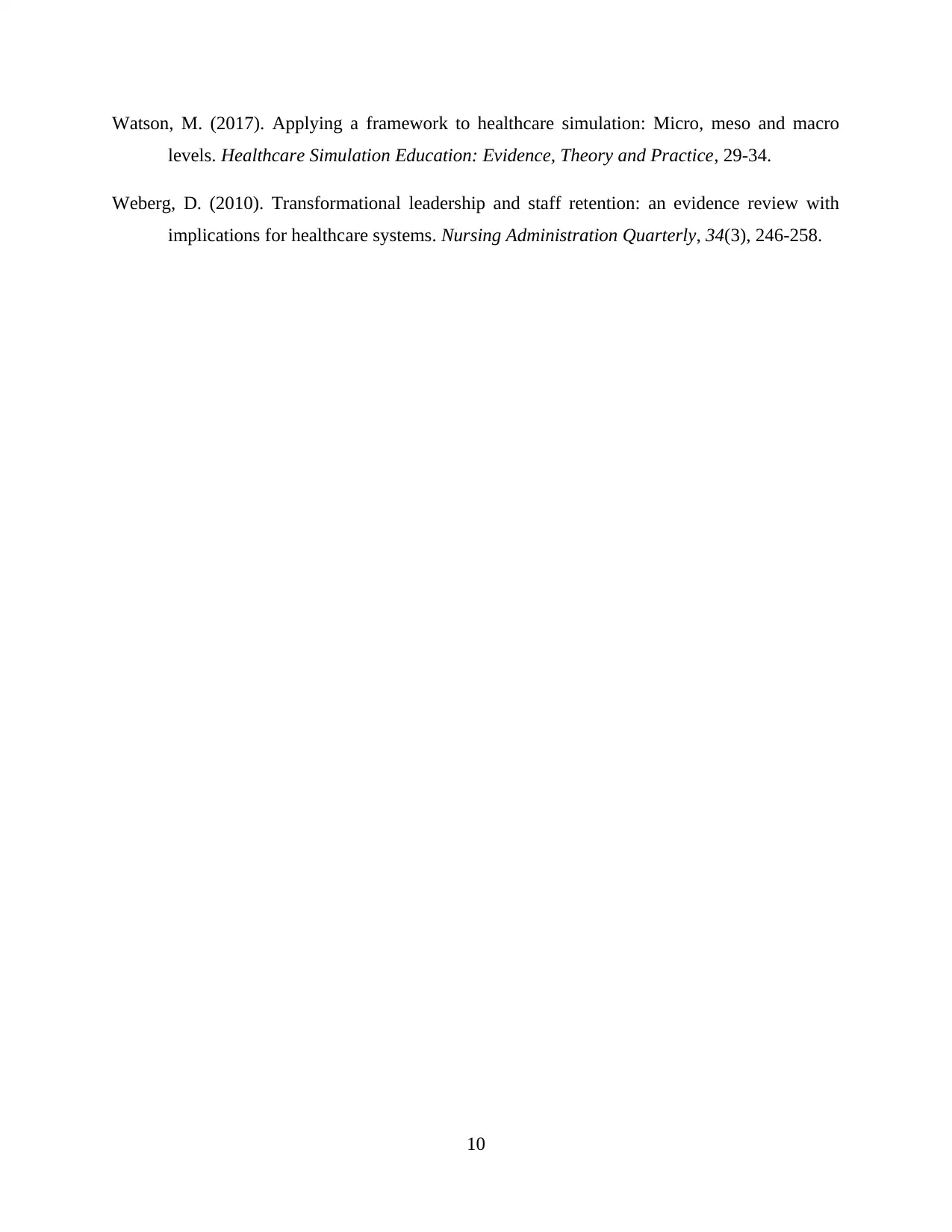
Watson, M. (2017). Applying a framework to healthcare simulation: Micro, meso and macro
levels. Healthcare Simulation Education: Evidence, Theory and Practice, 29-34.
Weberg, D. (2010). Transformational leadership and staff retention: an evidence review with
implications for healthcare systems. Nursing Administration Quarterly, 34(3), 246-258.
10
levels. Healthcare Simulation Education: Evidence, Theory and Practice, 29-34.
Weberg, D. (2010). Transformational leadership and staff retention: an evidence review with
implications for healthcare systems. Nursing Administration Quarterly, 34(3), 246-258.
10
1 out of 11
Related Documents
Your All-in-One AI-Powered Toolkit for Academic Success.
+13062052269
info@desklib.com
Available 24*7 on WhatsApp / Email
![[object Object]](/_next/static/media/star-bottom.7253800d.svg)
Unlock your academic potential
Copyright © 2020–2025 A2Z Services. All Rights Reserved. Developed and managed by ZUCOL.




